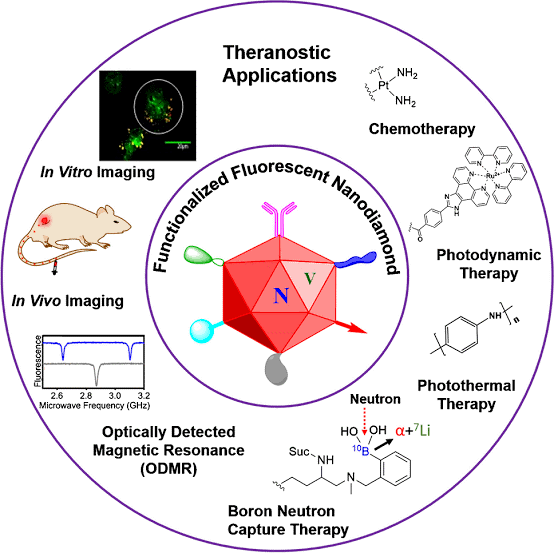Revolutionizing Physics: The Quantum Potential of Fluorescent Nanodiamonds
Syllabus:
- GS 3: Science and Technology: Development and its Application
- Awareness in the field of IT, Biotechnology, Nano-Technology etc.
Why in the News?
Scientists at Purdue University have levitated and spun fluorescent nanodiamonds (FNDs) at ultra-fast speeds, revealing new insights into quantum physics and potentially revolutionizing their industrial and research applications, especially as sensors
Quantum Spin
- Definition: Spin is a fundamental property of matter, combining two states: up and down. This spin property is crucial for data storage in quantum computing systems.
- Mapping Values: Spins can be mapped to binary 0s and 1s, enabling particles to encode data, much like how magnetic hard drives store information.
About Fluorescent Nanodiamonds (FNDs)
- Carbon-based Nanoparticles: FNDs are nanometre-sized diamonds composed of carbon nanoparticles, produced under high temperature and pressure conditions.
- Fluorescence Property: They emit light of lower frequency when irradiated with high-frequency light, remaining stable without blinking over long durations.
- Non-toxic & Biocompatible: FNDs are non-toxic and safe for use in biological systems.
- Applications: Widely used in high-resolution imaging, temperature sensing, and correlative microscopy.
- Unique Lifespan: FNDs have a longer fluorescence lifespan compared to other nanomaterials, making them ideal for advanced applications.
- Spin Qubits: Quantum computers use spin qubits, particles manipulated via their spin states, to perform operations.
- Electron Spin: The electron’s spin state is critical in quantum operations, enabling complex calculations and operations in quantum computers.
- Applications: Understanding quantum spin aids advancements in quantum computing, opening doors for more efficient information storage.
The Berry Phase
- Definition: Berry phase refers to the phase shift of a wave when its state cycles through different configurations before returning to its original state.
- Importance: Measuring Berry phase helps understand quantum effects and the properties of materials like topological insulators.
- Recent Findings: Purdue researchers measured the Berry phase of FND spin qubits due to ultra-fast spinning, advancing applications in quantum research.
- Wave Nature: When electrons act as waves, properties like frequency, wavelength, and phase become essential in quantum mechanics.
- Historical Context: Named after Michael Berry, the Berry phase concept was generalized in 1986 and initially discovered by Indian physicist S. Pancharatnam.
Testing the Limits of Physics
- Quantum Mechanics: Reconciling quantum mechanics with classical physics, particularly gravity, is a fundamental challenge in modern science.
- Experiment: Purdue researchers successfully levitated and spun FNDs up to 20 million times per second in high vacuum conditions.
- Spin Qubits: This study demonstrated control over FND spin qubits, crucial for future experiments in quantum mechanics and testing gravitational effects.
- Stable Rotation: The method ensured highly stable, controllable rotation frequencies of levitated nanodiamonds.
- Past Challenges: Earlier studies faced difficulties in maintaining levitation and observing spin qubits in a vacuum, now successfully addressed by the Purdue team.
Industrial Applications
- Sensors: Levitated FNDs are sensitive to acceleration and electric fields, making them ideal for applications in sensor technology across various industries.
- Gyroscopes: The Berry phase generated by rotation opens possibilities for developing gyroscopes for precise rotation sensing.
- Enhanced Properties: FNDs can be doped with other elements, improving their electrical, magnetic, thermal, or optical properties for specialized applications.
- NV Centers: Nitrogen-vacancy (NV) centres in FNDs allow control of spin qubits, emitting light of different colours when irradiated with lasers.
- Strategic Use: The unique properties of FNDs can be applied in high-value industries and research sectors, enhancing performance and innovation.
FNDs in Research and Industry
- Microscopy and Imaging: FNDs are widely used in high-resolution imaging, temperature sensing, and correlative microscopy due to their stable fluorescent properties.
- Biological Tracking: In biology, FNDs track cells over extended periods without degradation, offering precise insights into cellular functions.
- Comparison with Quantum Dots: FNDs outperform quantum dots, boasting a longer fluorescence lifespan, making them valuable for continuous imaging applications.
- Disco Effect: When irradiated with lasers, levitated FNDs emit light in various colours, showcasing their potential in optical technologies.
- Revolutionary Impact: From quantum physics research to industrial sensors, FNDs are set to influence multiple fields, contributing to breakthroughs in both theoretical and applied physics.
Conclusion
Fluorescent nanodiamonds represent a breakthrough in both quantum and applied physics, offering possibilities for quantum research and technological advancements. Their unique properties position them as vital tools for revolutionizing industries ranging from computing to high-resolution sensing.
Source: The Hindu
Mains Practice Question:
Discuss the potential applications and implications of fluorescent nanodiamonds (FNDs) in quantum mechanics and industrial sectors. How do recent advances in manipulating FNDs contribute to breakthroughs in modern physics and technological innovation?




